Kashmir Great Lakes Trek or simply KGL, is one of the most splendid treks in the Himalayas. Located in Jammu & Kashmir, it can be accessed from Sonamarg, which is the nearest town. It runs along the Shamsabari range (an offshoot of the Great Himalayan Range), with the Gurais valley to its north and Sonamarg valley to the south.
The trek’s name is derived from a series of high altitude oligotrophic lakes along its route – Nund Kol, Gangabal, Satsar, Gadsar, Krishansar, and Vishansar. Besides these, a few others like Kaulsar and Wattalsar are equally beautiful but lesser-known as they are located off the main route.
The trek route passes through lakes situated at altitudes of 12000 ft and mountain passes at 12500-3800 ft. It also touches the base of the majestic Harmukh peak (altitude 17000 ft), which is revered as the abode of Lord Shiva in Kashmiri folklore.
KGL is an experience of a lifetime and I hope this write up will give you an insight and assist you in planning a great trek. Towards this end, I have tried to cover all relevant details and share important inputs.
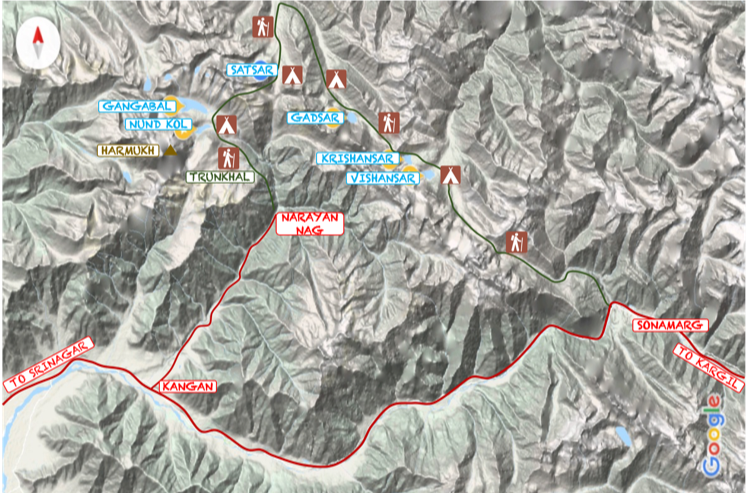
Day 1 : Trek to Nund Kol
We started from Wussan at 6.30 AM in a taxi for the start point at Narayan Nag. All along the scenic drive, the mighty mountains beckoned us through the hills that were dotted with lush maize fields. Upon arrival, we were met by Khalid and Aslam, our porters for the trek with their two Himalayan stallions. Post a brief chat and a quick adjustment of our loads, at 9 AM. we headed up on the cobbled path that led to the hillside through a fairly dense forest of pine and deodar trees. We could hear the muffled sounds of the stream flowing below as the crisp mountain breeze ruffled our hair. Occasionally, we saw other trekkers, some taking a break to catch their breath, some to just soak in the beauty of untainted nature, and a few others who were heading down (I assumed they had started the trek from the other direction. I shall cover this later).
The first day of the climb is the most difficult part of the entire trek. Though not very steep, it’s a continuous climb for a considerable distance before the landscape starts to flatten out. At around noon, we emerged from the shadows of the forest and reached an open meadow known as Trunkhal. It is here that we got our first glimpse of the mighty Harmukh mountain, which is considered as the mini Kailash. Engulfed in clouds, we could see the mountain and the sprawling meadows along its slope. Dotted through the meadow were the huts of the Gujjar and Bakarwal communities, the only human inhabitants who come up to these heights in the summers with their horses and livestock for grazing on the meadows along the slopes. After a quick stop for refreshments, we carried on towards our campsite, which was still halfway from Trunkhal. From this point on, the landscape transformed: there were no trees; just rolling grasslands with some boulders jutting out here and there; and mountain streams making their way down the hills.
At around 4.30 PM we reached our campsite at Nund Kol (altitude 12000 ft). There were a few other trekkers also present and we started to pitch up our tents. Suddenly, the sky turned dark and it looked like we would be getting drenched on the very first day itself. We sped up our efforts, managing to finish just in the nick of time before the rain and wind came lashing down at our makeshift home. It was an intense but thankfully, brief spell, which subsided by 5.30 pm and we could see the sun shining on the horizon behind Harmukh. We let our porters make the balance arrangements and made our way towards Gangabal lake, which is located just 700 meters upstream and feeds water to Nund Kol. Gangabal is the biggest of the lakes along the trek, its waters come from the melting of the Harmukh glacier. Revered by the Kashmiri pandits, the lake offers a magnificent view of its distant shore as the sun sets behind the Harmukh mountain.
Day 2 : Trek to Satsar
If you are an early bird like me, you can catch the sun making its way out of the mountains as it casts its golden rays onto the Harmukh mountain. After the stunning sunrise, we made our way towards Satsar, our next night halt. We climbed up further and higher towards Zajibal Gali (Gali means a mountain pass) at an altitude of 13500 ft. From the top of the pass, we had our last glimpse of Harmukh, Gangabal and Nund Kol, before resuming our trek to Satsar. This particular stretch is a bit strenuous because there are big boulders all around necessitating caution while going over, since any carelessness might result in injuries and that’s the last thing you want in the wilderness. The landscape seems as if the entire mountain has come crumbling down under some brute force of nature as big boulders the size of cars are strewn all around as you move through the area.
After a brief trek, we reached Satsaranbar Gali (altitude 12800 ft), which is the entrance of Satsar lake. Satsar lake is made up of a series of seven ponds that are placed one after the other. As we crossed the Pass, we saw the first of the lakes as well as the subsequent lakes along the trail. Finally, at 1 PM, we reached the last of the seven lakes (altitude 12000 ft), which is also the smallest of all the lakes along the trail. Here, we established our campsite close to the huts of a Gujjar dwelling. Even though it was peak afternoon, the wind was very strong and chilly because of the lake being very close to the Pass. This acts as a conduit for the wind, thus cold windy conditions persist throughout the day. We saw the majestic Himalayan horses and the herds of sheep and goat of the local people. At night, the sky came alive with the spectacular sight of the various constellations, something we rarely get to see in our city skies.
Day 3 : Trek to Gadsar
This part of the trek is relatively easy as both the lakes are situated at about the same altitude and the route passes through minor undulations before reaching the Gadsar campsite. Trekking through some of the finest meadows along the entire stretch of the trek, we saw torrents of mountain streams and a huge variety of wildflowers along the mountainside, making it appear as if we were passing through a valley of flowers. We made our way through the small summer settlements of the Gujjar and Bakarwal communities, greeting them as they called out to us cheerfully. We started from Satsar at 10 AM and after a laidback trek reached the Gadsar campsite (altitude 12500 ft) by 1 PM. This campsite is near a stream of fast-flowing water known as the Gadsar Nala as there is no suitable flat ground for camping near the Gadsar lake, which is located further 3 km upstream.
Along the way, we came across remnants of snow, though it was more brown than white by then. We saw Marmots (Himalayan rodents), which are as big as rabbits; a variety of wildflowers; summer birds like the Yellow Hummingbird; and the Himalayan horses that were in plenty. The campsite was bustling with other groups: some having travelled along our path and some travelling in the reverse direction. Overall, it was a good break in the evening combined with a good read (I carried my Kindle) after two days of strenuous climbing. At night we cooked our food by the side of the stream and retired for the day, only to be woken up by occasional bear growls in the far distance.
Day 4 : Trek to Krishansar/Vishansar
It was the fourth day of the climb, and I was longing to see the twin lakes of Krishansar and Vishansar. The photographs of their splendid beauty had captivated me as also, the prospect of finding fresh trout in these lakes, said to be the home of the finest trout in the region. We began our climb at 9 AM, and the first thing we came across was the Gadsar lake (altitude 13000 ft.). It was a beautiful bowl of freshwater formed from the melting of a glacier located just above the lake. We stopped briefly to enshrine the magnificent natural reservoir of water into our memories, making a promise to return some day before moving further and starting the gradual ascent towards the highest point of the trek, the Krishanbar Gali (altitude 13800 ft). It was a beautiful day, the skies were covered in clouds, protecting us from the penetrating rays of the sun. At the crest of the Pass, we caught our first glimpse of the twin lakes. It was an amazing sight with both the lakes like steps of a stairway, perched one atop the other. We stopped to capture those moments and for some water and refreshments.
Then we headed down to a sprawling open camping ground at the base of Vishansar lake (altitude 12800 ft). We crossed a placid stream of water flowing out from Vishansar lake before finally reaching our campsite at 1 PM. The area of the campsite was strewn with a number of Gujjar and Bakarwal dwellings all along the lake. In my quest to find out about the trout, I was thrilled to find a man who not only had a hut at the lakeside but also the fishing tools I needed. Overjoyed at my luck, I caught the trout and carried it back to the camp for dinner. Afterward, we explored the campsite and sat down to enjoy our last Himalayan sunset. At night, it rained a little, as if to echo our sadness at the trek drawing to its end.
Day 5 : Trek to Sonamarg
At 9 AM, we left for our final destination, Sonamarg. En route, we crossed Nichnaibar Gali (altitude 13500 ft), the last Pass before moving downhill. In the distance, we could see the mountains that are home to the Amarnath Cave, and they looked as beautiful as one could imagine them at close quarters. Then, we started our downward spiral along a mountain stream and at a distance, we could see Sonamarg. As we went down further, the landscape changed from open meadows to forests again, and we were back moving through the trees once more. We saw Bhojpatra trees, known for their white bark which was used to write ancient scriptures. Here, we crossed people making their way up for the trek and it made me kind of jealous because their journey had just started while mine was about to end. Finally, at 4 PM we reached the highway which connects Srinagar to Sonamarg, and further to Kargil and Leh.
Throughout the entire trek, the gods had been kind and the weather remained favourable making it an even more enjoyable and unforgettable experience. This was the fifth day and during the entire trek, we’d had minimal human interaction, no mobile network, no worries, and no pollution. It was a completely different world from the one we live in, and so much more beautiful and serene. And though our journey had come to an end, we knew its memories were going to be etched forever in our hearts.
Favourable Season
The trek can be undertaken from mid-May to mid-September. This region is subject to extreme weather conditions mid-September onward (heavy snowfall up to 20-30 ft and sub-zero temp up to -30 deg Celcius), and it’s only around mid-May that the snow begins to subside. Before setting out for the trek, be updated on the expected weather conditions so as to plan accordingly.
Accessibility
The nearest airport is at Srinagar. From there one can either take a taxi or a local bus to Sonamarg. For the trek, you can contact a number of travel operators who organise the entire trip including food and lodging arrangements that are in the form of makeshift tents, which are put up by them. I did the trek with my wife, and we hired two porters with their ponies for carrying the extra load as well as for cooking food. One can start from either Sonamarg or Narayan Nag. The distance is the same but in my opinion, it is better to climb from the Narayan Nag side and culminate at Sonamarg.
Distance
The trek covers a distance of approx 80-85 km. It can be undertaken in five days comfortably. For people wanting to explore more along the trail, the duration can be increased as per their convenience keeping in mind the ration requirements for the period. You can choose to halt at Nund Kol or Vishansar campsite for an additional day or two.
Difficulty
The trek is moderately difficult and needs some level of physical fitness. The climb on the first day is the most challenging but flattens out into gradual climbs later. The last day of the climb is the longest as one goes down towards the valley. This is the same for both the starting points of the trek, i.e. Sonamarg as well as Narayan Nag. The trek can be undertaken by a person with average fitness levels, but, if you are not a regular fitness enthusiast, then you may need to start working out a bit before you embark on this trek.
Travel Essentials
Basic Essentials
- ID Card
- Backpack with Rain Cover (50-60 ltrs) (I had put it on my pony)
- Daypack with rain cover (20-30 ltrs)
- 1 ltr water bottle
- Waterproof trekking shoes
- LED torch
- Lighter
Clothing
- 2-3 pairs of quick-dry T-shirts (full sleeve) and track pants
- 3-4 pairs of cotton/woolen socks
- 2 pairs of thermal inners
- 1 Down feather Jacket (preferably waterproof)
- 2 Woolen balaclava (one that covers ears)
- UV protection sunglasses
- Scarf, gloves, plastic bags (for wet clothes)
Personal Kit
- Toilet Kit
- Anti-fungal cream (may come handy as one sweats a lot during trek)
- Lip Balm, Sun Screen (SPF 40+)
- Camera with fully charged battery/extra batteries & extra memory cards
Eatables (For Trek)
- Glucose or Tang, Chocolates, Energy Bars, Toffees & Dry Fruits
- Food for the trek would be arranged by your travel organiser if you go for an organised trek. I carried my own rations as I went for the trek independently.
Medicine Kit
- First Aid kit
- Medicine for minor ailments
Click on the photos to see the full picture
Share
Picture Credit : Vibhor Tyagi
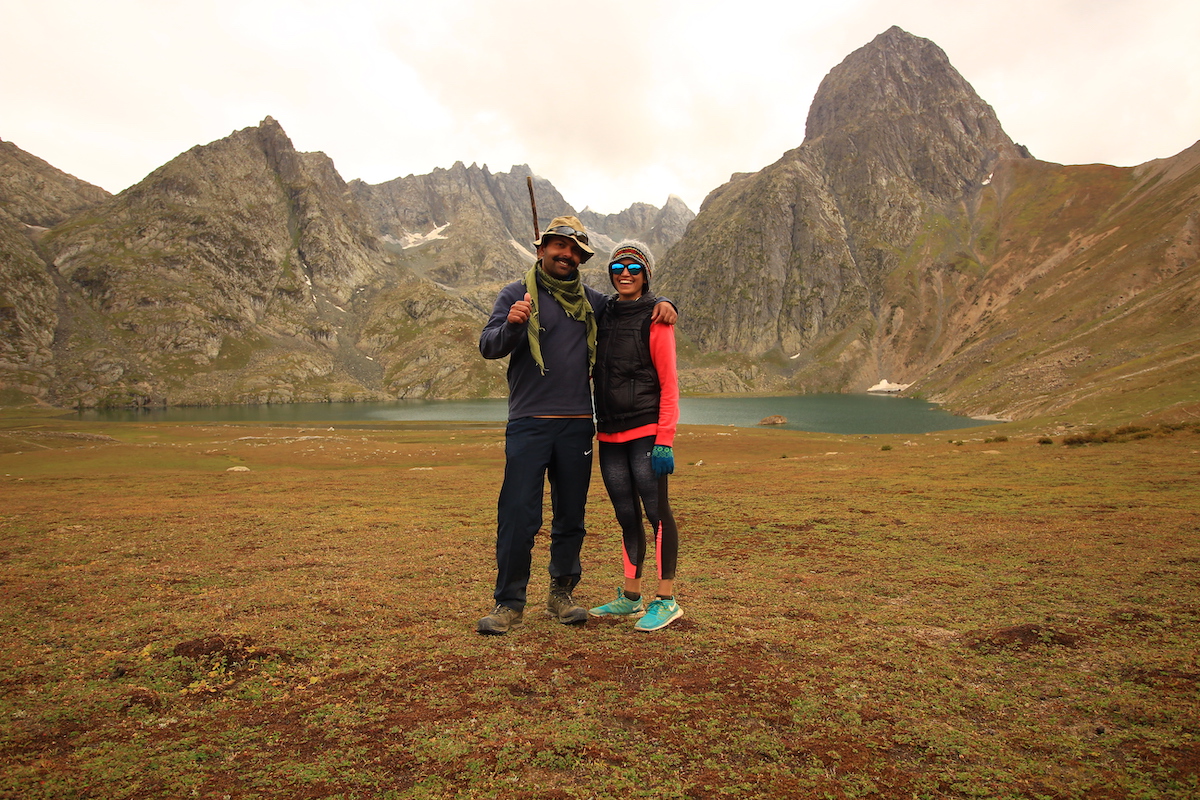


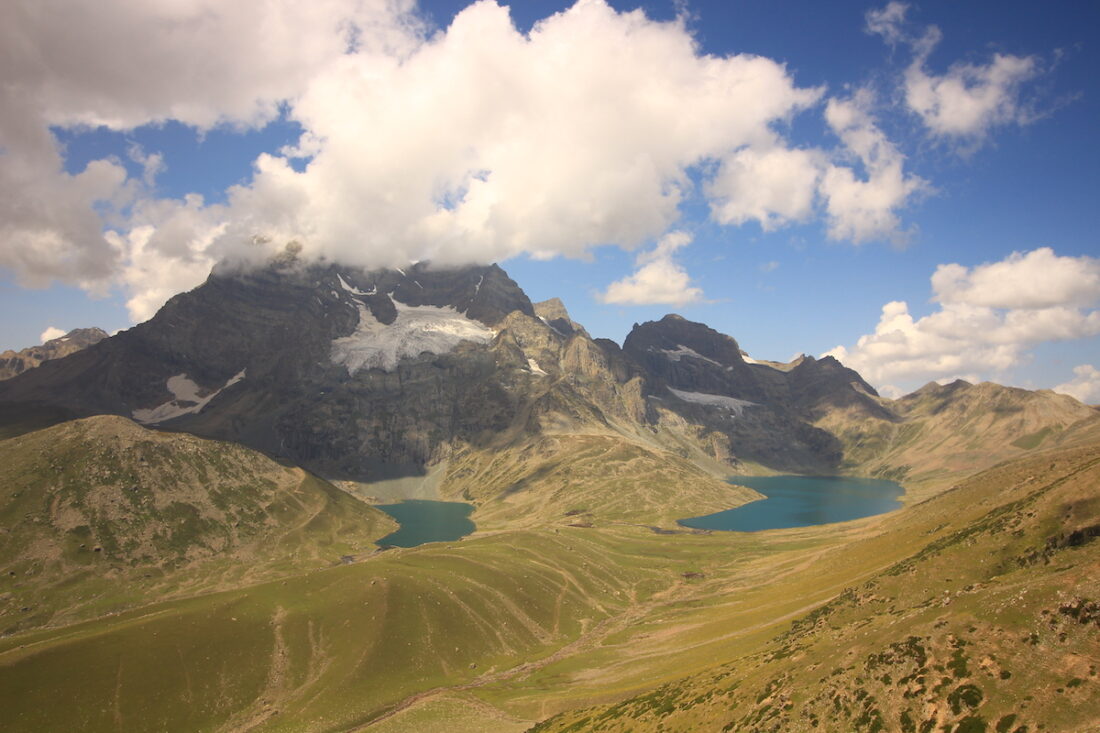
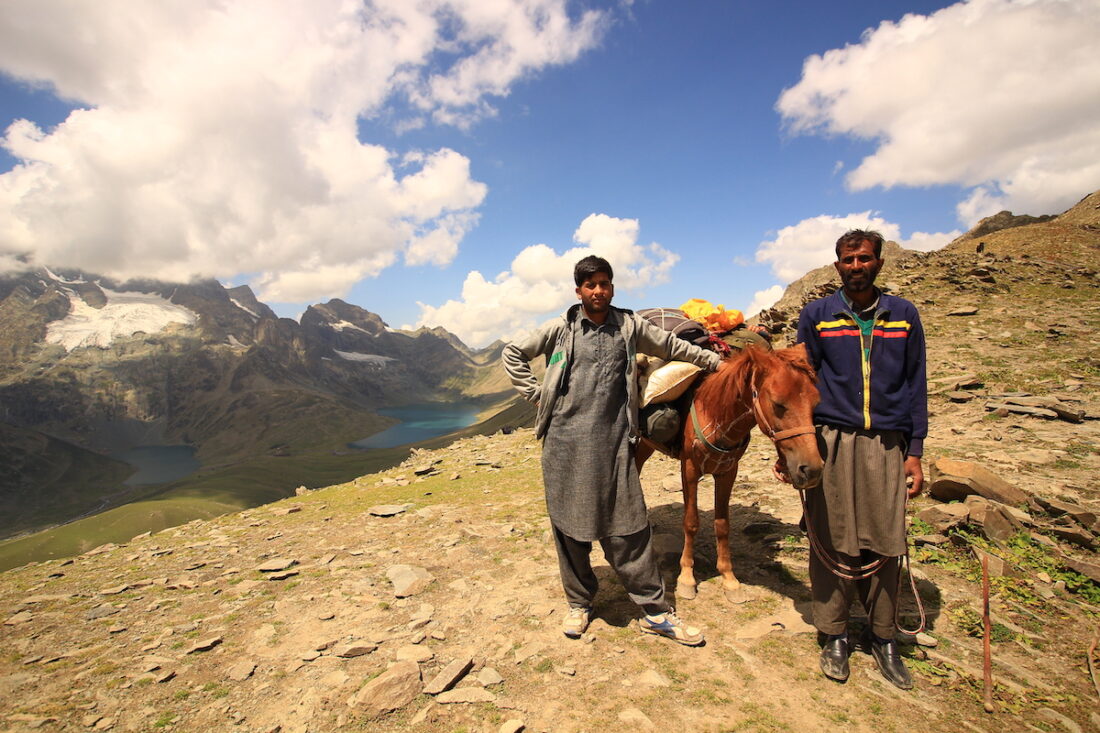
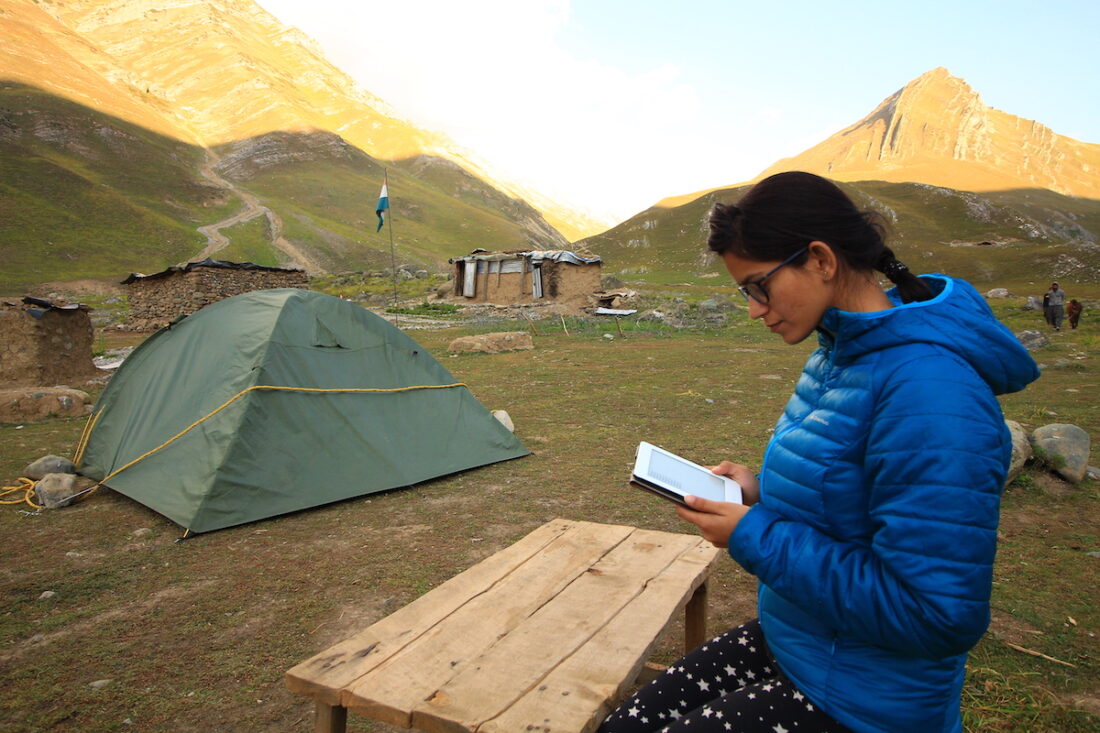
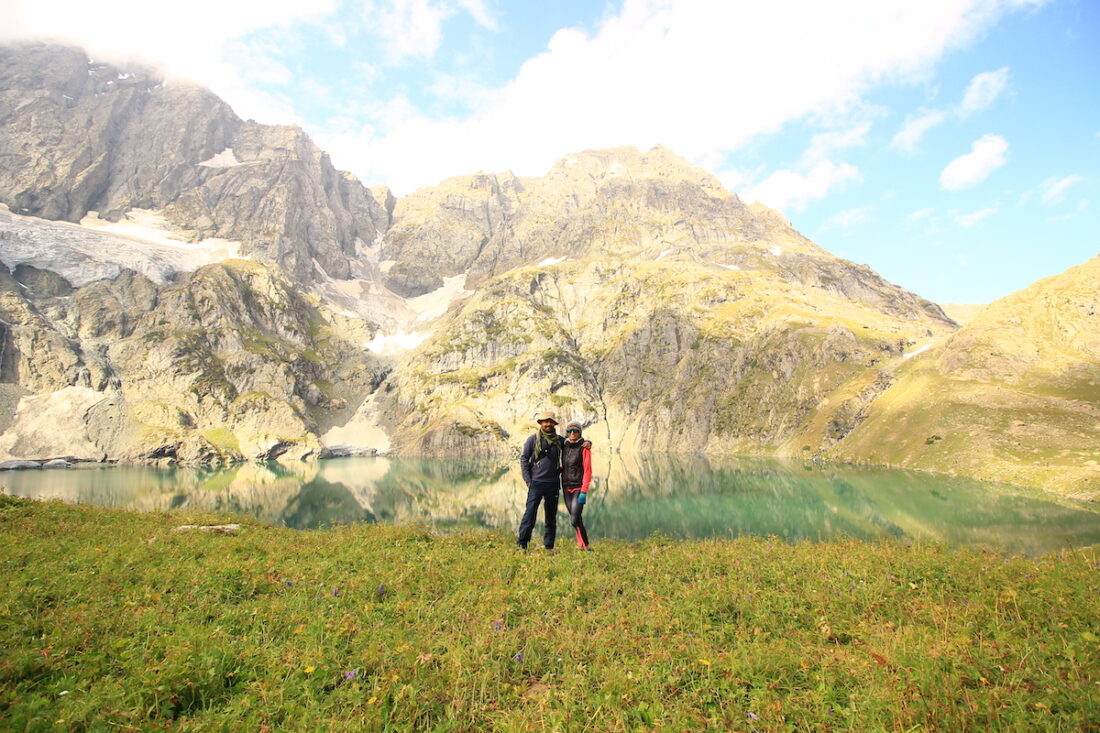
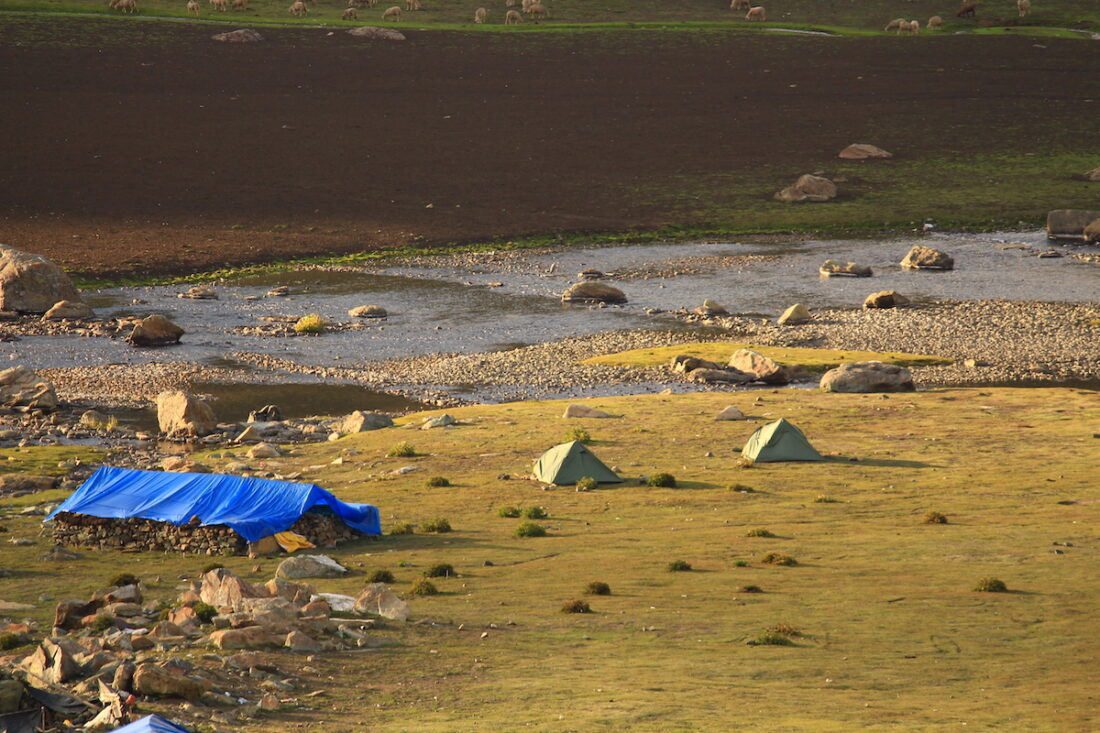


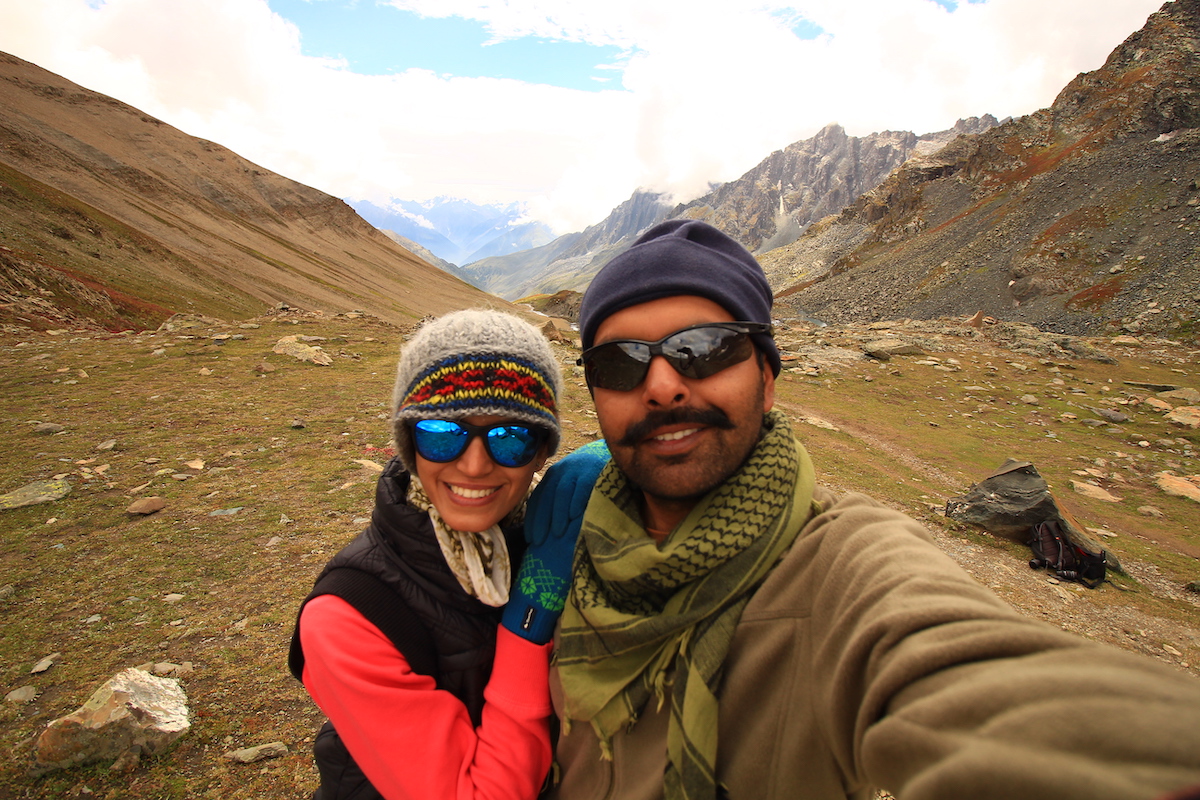
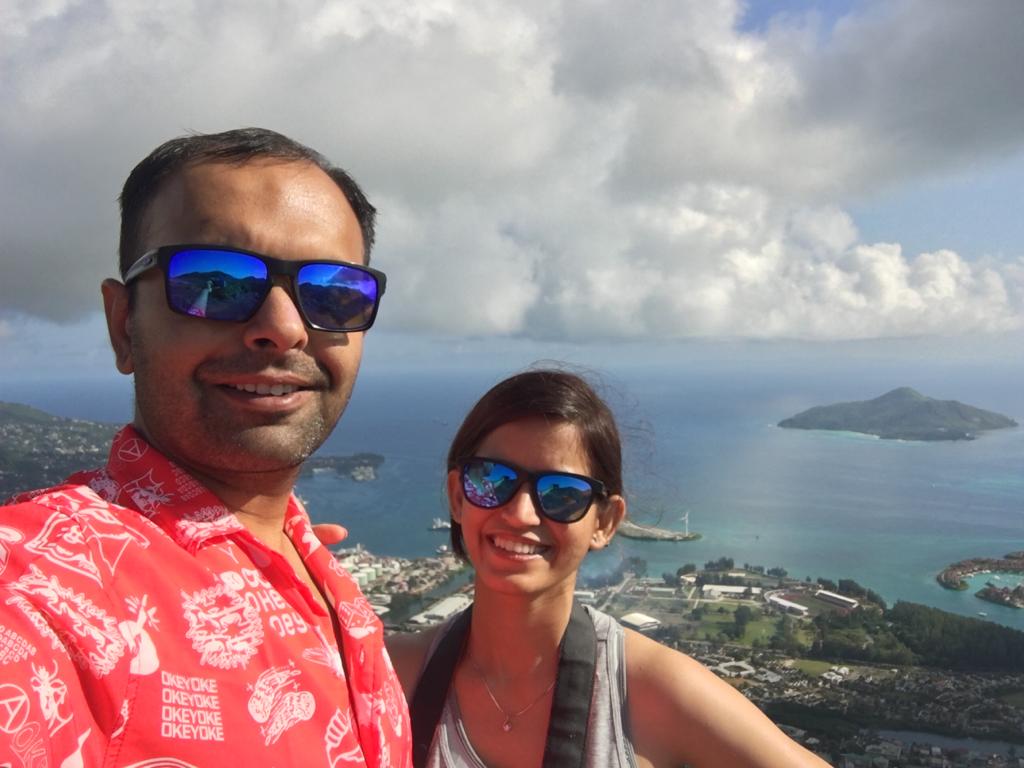
Just reading through the text intrigues you so much so that one feels the urge to pack up and head for the trek. You have added a fine touch to the mersmerising spectacle of mother nature. A beautiful narration made even more informative with the useful additions of “Travel Essentials”.
Thank you for your inspiring words sir
Reading your travelogue was surely so very interesting…..I derived a vicarious delight ,marvelling at the beauty of the area described by you . Thanks & keep it up ……
thank you sir for your gracious appreciation.
Well written article which will assist in effective planning of the trek… Bravo..
Thank you sir ..👍🏼
It’s informative and exciting Good to know so much about the himalayan ranges. Would love to go once, though trekking is not everyone’s cup of tea. Keep it up.
Thanks
If you have slightest of inclination for treks then you must do this one. You would remember me for recommending this one.
The article is beautifully written. I can only imagine the experience you guys had, but it sounds wonderful 😍
Thanks for the support Harshil
Excellent… very well covered 👍👍
Thank u sir
Very well narrated , drew a lot of inspirations from the blog, Excellent article.
Good good to have inspired someone in a positive direction. Thank u very much
Very well covered, rather planned & executed trip. Your article is not only motivating but too showcasing the hidden treasures of heaven in the valley. An admirable article.
Thank you for the inspiring words
Well written !! Loved the detailed description of your entire journey 🙂 looking forward for more such blogs from you 🙂 \m/.
Thanks. Will surely share my other travel articles as well
Beauty lies in the eyes of the beholder..The way Vibhor narrated the beauty of the majestic Himalayas, the lakes and the surrounding nature makes it more picturesque. Waiting to undertake this journey soon…Thanks for the detailed checklist in the end…
It’s good to hear that it could be of some assistance to another traveller
Simply superb
Thank u 🙏🏼
Great work and it feels like seeing the place through your eyes. This article is not just a description but also a motivation for those who read to pack their bags for a trip. Hope to read more about your adventures. Best wishes.
Thanks for your time and valuable feedback. Will share other articles as well.
The detailed account of your experience and description of nature is in complete sync. Also, listing of essentials at the end is noble and practical as good numbers of us are not very clear what to carry and what to not. Keep up your literary skill and keep bringing us your experience. Stay blessed.
Thanks for inspiring me further.
Very vivid description of the trek Vibhor. Will assist numerous nature enthusiasts in planning one. Perhaps the not so energetic ones will be enticed to join the bunch.
Thank u sir for your ever encouraging words.
A TREK WORTH TAKING
Indeed it is sir. #guraisdiaries
Very well covered in great detail. A great description of a adventure trek.
Thanks a lot
Very well written. While reading, I could imagine myself going through the trek. You’ve an amazing talent of bringing words to life. Keep up the good work sir.
Mentioning about the essential items At the end was very prudent as it’ll assist novice trekkers to plan their trip
God speed sir
Thanks buddy for your highly inspiring words.
I did this trek a few years ago … was my most picturesque one , having done ABC, EBC ,annapurna circuit, markha valley to name a few .. It was tough in most parts the morraine walk was scary. But my most favorite trek .
It is one of those things that you would love to do again
Vibhor, your naration was so lucid and engaging. We could see the whole trip through your eyes.
I wish I could have undertaken the trip while I had the chance. But no worries, God willing some day I will.
Keep your adventure and trekking hobbies alive and explore more places. Be an inspiration and motivation for others. God Bless…
Thank you sir for motivating me further. I’m sure you would plan for this one day.
Very well covered sir, loved reading this article. It motivates me to explore such hidden beauties of our mother earth. Hope to join you in next trek mission.
Thanks buddy, would plan one together.
Wow…. Vagabond couple ….You are doing great and rightly tempting the other mountain goats to explore ….more power to your Legs ..camera and pen …waiting for more ..
Thank you ma’am for your inspiring words. That serves as a motivation for future endeavours.
Very well written. The entire landscape seems to unfold as one reads through the article.
Thank you for your valuable words
The article unfolds the complete landscape like a carpet in front of your eyes. Kudos.
Thanks Prachi for taking out time.
Thank you for valuable words
Good one Tyagus 👍
Hi, completed this trek in July, last year(2022). It rained continously throughout the trek because of which there was sleet, slippery slush on the slopes, making this trek dangerous ! There were many groups on the slopes, I was getting a lot of compliments on undertaking this trek “at my age ” (60 years) , making me feel almost like a relic !!!
You both are lucky to have a partner who shares your passion for trekking, cycling, etc. All the best for many adventures that will come your way 😀